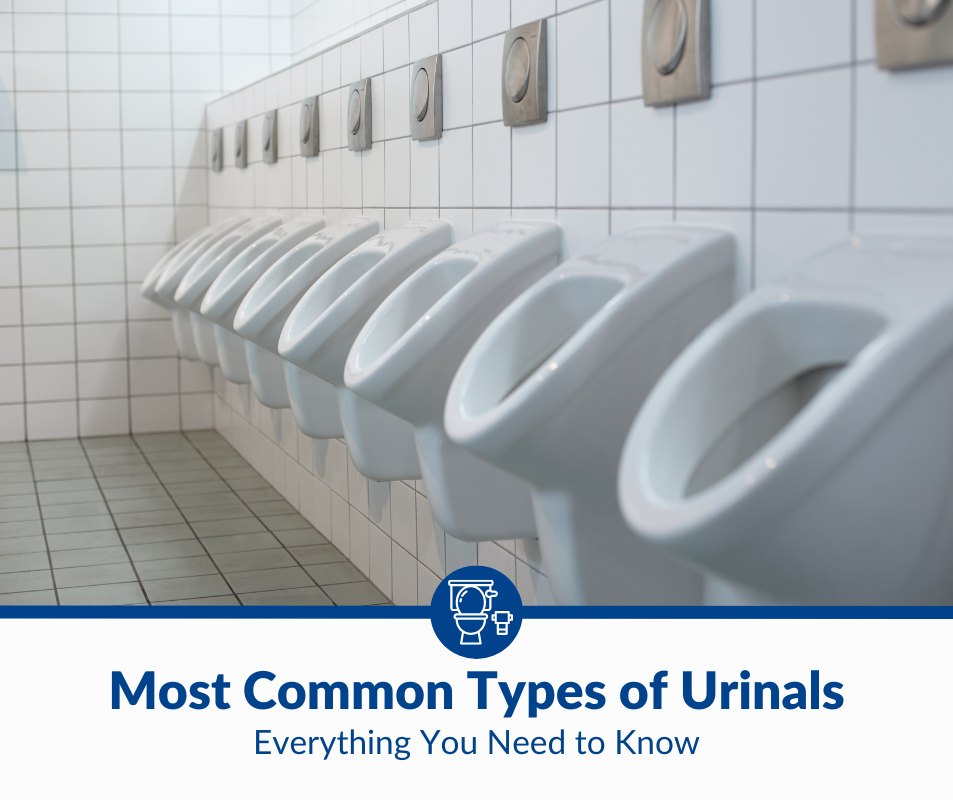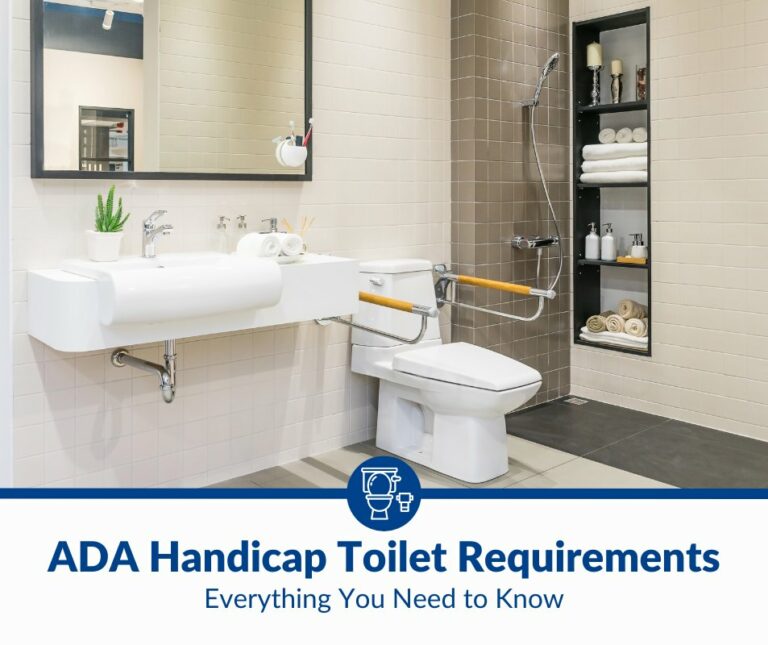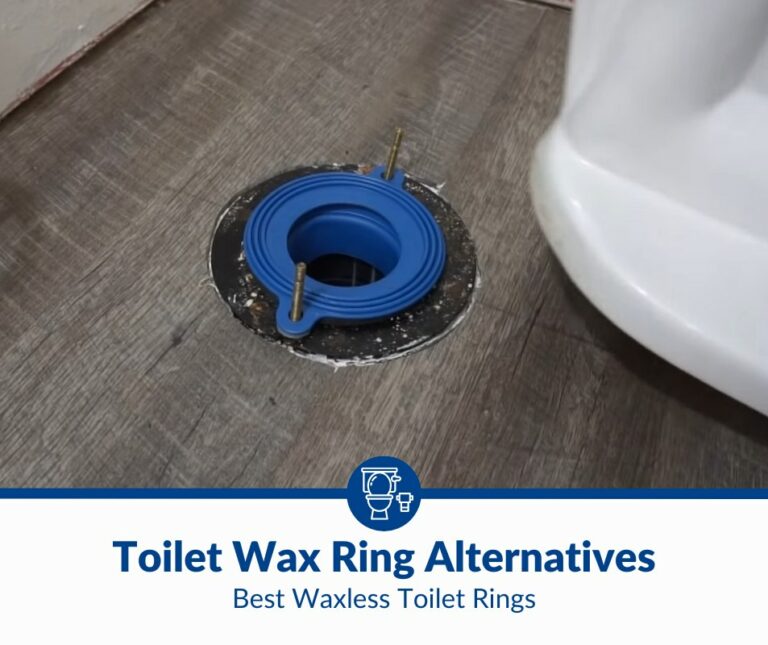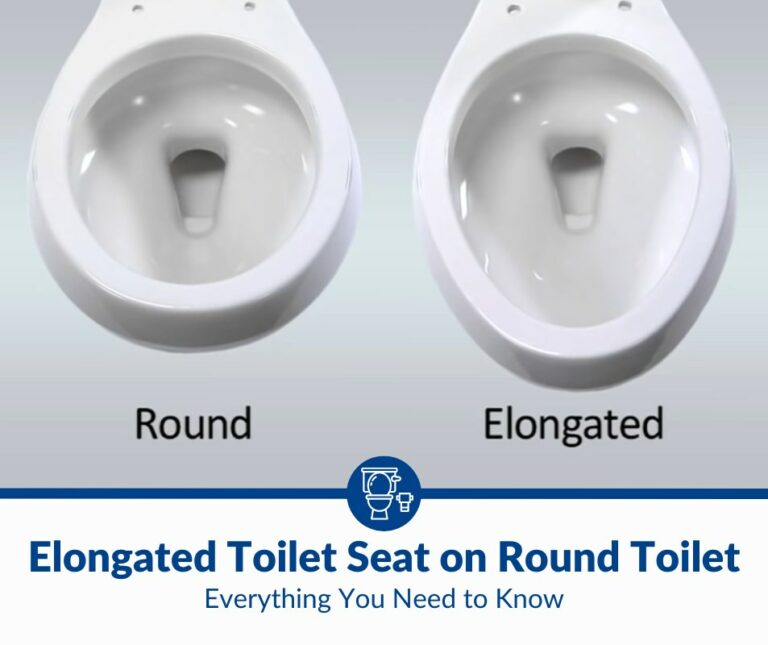Most Common Types of Urinals: The Complete Guide
The most common types of urinals to consider for your next project are wall-hung, floor-mounted, pressure-assisted, and waterless urinals. These urinals offer unique benefits and features, making them the perfect fit for various bathrooms, including commercial, residential, and public bathrooms.
Urinals are a common sight in public restrooms, but did you know there are several different types available? There are a variety of urinals from which to choose, from traditional wall-mounted models to waterless and sensor-operated options. Depending on the style and purpose of the restroom, one type of urinal may be more suitable than another.
Choosing the right type of urinal for a business or public restroom is essential as it can significantly impact the functionality and overall aesthetic of the space. Different kinds of urinals offer different features and benefits, such as water efficiency, ease of maintenance, and user convenience.
It’s crucial to consider factors such as the purpose of the restroom, the number of users, and the overall design aesthetic when selecting the best type of urinal for a particular space.
The rest of this article will provide a comprehensive guide on the most common types of urinals available. It aims to inform readers about the various types of urinals and their features, benefits, and drawbacks so that they can make an informed decision when selecting the best type of urinal for their specific needs.
Overview of Urinal Types
- Wall-hung urinals are the most traditional type of urinal and are mounted directly onto the wall. They come in a variety of sizes and designs that are easy to maintain and provide a clean, aesthetically pleasing look.
- Floor-mounted urinals are typically used in larger restrooms or commercial settings. They can be more expensive than wall-mounted urinals but offer more stability and are less likely to be vandalized.
- Pressure-assisted urinals use air pressure to flush the waste away quickly and efficiently. They are typically used in high-traffic areas, such as stadiums or airports, and are designed to reduce water consumption.
- Waterless urinals, as the name suggests, don’t use water to flush waste. They use a trap and seal system that uses a liquid sealant to trap odors and keep the urinal clean. These urinals are more water-efficient and may be a good option for businesses and public restrooms looking to reduce their water consumption.
Key Factors To Consider When Choosing a Urinal
While many different types of urinals are available, it’s important to consider several key factors when selecting the best type for your space. These include:
- Size. The size of the urinal you choose will be determined by the size of the restroom and the number of users. It’s important to choose a size that is appropriate for the space and will comfortably accommodate the number of users.
- Water efficiency. The water efficiency of the urinal is a critical consideration for businesses and public restrooms looking to reduce their water consumption and save money on water bills. Waterless and pressure-assisted urinals are typically more water efficient than traditional wall-mounted and floor-mounted models.
- Style. The style of the urinal will be determined by the overall design and aesthetic of the restroom and the preferences of the business or homeowner. Many styles and designs are available, from traditional wall-mounted models to more modern, sleek designs.
- Maintenance. Consider how easy it is to clean and maintain the urinal. Some models are more complex and may require professional cleaning, while others are simple and easy to maintain.
- Cost. The cost of the urinal will be determined by its type and features. It’s essential to consider the upfront and long-term costs of ownership, including maintenance, water usage, and repair costs.
- Accessibility. It’s important to consider accessibility for people with disabilities. Some urinals can be designed to accommodate users in wheelchairs, an important consideration for public restrooms.
By considering these factors, businesses and public restrooms can choose the best type of urinal to meet their specific needs and ensure the best user experience.
1. Wall-Hung Urinals
Wall-hung urinals are efficient and versatile plumbing fixtures mounted directly to the wall at any height. They come in various sizes and designs, from simple to more elaborate models, with features such as automated flushing or antibacterial surfaces to reduce the spread of germs.
Wall-mounted urinals are ideal for use in commercial and public restrooms where space is limited. However, they can be more prone to vandalism if not securely mounted or monitored and may require more maintenance than other urinals.
These urinals typically have a flushometer valve that controls water flow and a trapway that collects and disposes of waste. They can be connected to various water sources and plumbing configurations, making them very versatile.
Features and Benefits of Wall-Hung Urinals
Wall-hung urinals offer several features and benefits that make them an efficient and practical solution for various restroom applications:
Easy To Clean
One of the most significant benefits of wall-hung urinals is that they are easy to clean. The design of the fixture allows for easy access to the waste outlet and flushometer valve, which means that cleaning crews can quickly and easily remove any build-up of waste or debris.
Additionally, because wall-hung urinals are suspended above the floor, there is less chance of splashing and less surface area for collecting dirt and grime.
Modern Appearance
Wall-hung urinals come in a variety of designs and styles that can be incorporated into a wide range of bathroom decor. Some are made from porcelain and have a traditional, classic look, while others are made from stainless steel and have a more modern and contemporary appearance.
This flexibility in design means that wall-hung urinals can complement any bathroom’s aesthetic, making them ideal for use in a wide range of settings.
Water Efficiency
While wall-hung urinals can be used with a variety of plumbing configurations, they’re often connected to low-flow flushometer valves that deliver a precise, measured amount of water per flush. This helps reduce overall water usage and can help property owners save money on utility bills.
Custom-Adjusted Height
Wall-hung urinals can be installed at any height, making them accessible for individuals of all abilities. These urinals can be used by people who are in wheelchairs or have mobility issues and by people who are taller or shorter than average.
This feature makes wall-hung urinals a versatile and practical solution for public restrooms, as they can be easily adjusted to suit the needs of a wide range of users.
Space-Saving Design
As the name suggests, wall-hung urinals are mounted to the wall so they don’t take up floor space. This can be especially useful in smaller restrooms, where every inch of floor space is at a premium. The space-saving design of wall-hung urinals means they can be used in a wide range of settings, including in smaller or unisex bathrooms.
Strength and Durability
Wall-hung urinals are typically made from high-quality materials such as porcelain or stainless steel. These materials are known for their strength and durability, allowing the urinals to withstand frequent use in restrooms.
Additionally, wall-hung urinals are sturdy and secure when mounted to the wall, preventing them from tipping over or becoming loose.
Potential Drawbacks of Wall-Hung Urinals
While wall-hung urinals offer many benefits, some potential drawbacks should be considered:
- Cost. Wall-hung urinals can be more expensive than traditional floor-mounted urinals due to the added cost of the support brackets. Additionally, the installation process for wall-hung urinals may require additional materials and labor costs.
- Installation difficulty. Installing a wall-hung urinal requires a certain level of expertise and experience. If the installation isn’t done correctly, it can lead to leaks or other problems. It’s also necessary to ensure that the wall is strong enough to support the weight of the urinal. It may not be feasible to install a wall-hung urinal in certain types of buildings or in certain areas of a building.
2. Floor-Mounted Urinals
Floor-mounted urinals are stable, durable, and traditional-looking plumbing fixtures typically found in commercial and public restrooms. They’re anchored directly to the floor, making them less likely to tip over or move.
Their traditional appearance makes them a popular choice for architects and designers. The design of floor-mounted urinals consists of a porcelain bowl mounted on the floor, with an inlet for water and an outlet for the drain.
The most common type of floor-mounted urinal is the top-fed style, which uses a tank or cistern to supply water for flushing. The flush systems vary, but the most common type is a manual flush, which requires the user to push down on a handle or lever to activate the flush.
Features and Benefits of Floor-Mounted Urinals
Floor-mounted urinals offer a range of features and benefits that make them a popular choice for many bathrooms:
- Durability. Floor-mounted urinals are typically made from porcelain, a material known for its strength and durability. This makes them suitable for heavy-duty use and ensures they can withstand frequent usage without needing to be replaced.
- Versatility. Floor-mounted urinals come in a range of designs and sizes, making them suitable for any type of restroom. They can also be used by individuals of any age or size, making them an ideal choice for public restrooms.
- Traditional look. Floor-mounted urinals have been used for many decades, and their design has remained relatively unchanged. As a result, they have a classic look that makes them a popular choice for architects and designers who want to create an authentic, timeless look in their spaces.
- Stability. Since floor-mounted urinals are installed directly on the floor, they are less likely to move or shift over time, which means they can withstand heavy usage without becoming loose or unstable. This feature makes floor-mounted urinals a durable and long-lasting solution for public restrooms.
- Relatively inexpensive compared to other types of urinals. They are a cost-effective solution for public restrooms, requiring fewer materials and labor to install than different types of urinals. They also have a simple and straightforward design making them easy to maintain and repair.
- Widely available. These fixtures can be purchased from most plumbing supply stores. This makes them easy to find and buy, which is especially useful for those who need to replace an existing urinal.
Potential Drawbacks of Floor-Mounted Urinals
Despite the advantages of floor-mounted urinals, some potential drawbacks should be considered before choosing this type of plumbing fixture:
- Cleaning difficulty. Floor-mounted urinals are more challenging to clean than wall-hung urinals, as the bowl’s design makes it difficult to access all areas of the fixture. This can lead to a build-up of bacteria and debris, which is unhygienic.
- Water usage. Floor-mounted urinals typically use more water than other types of urinals, which can be a concern for those who are trying to reduce their water usage or lower their utility costs. Additionally, older models of floor-mounted urinals may not be as water-efficient as newer models, which can result in higher water usage and higher costs.
- Inability to adjust the height. Floor-mounted urinals are typically placed at a fixed height, so the fixture cannot be adjusted to accommodate different users. This can make them less comfortable for those taller than average and may require additional accommodations to create a comfortable experience.
3. Pressure-Assisted Urinals
Pressure-assisted urinals are a type of urinal that uses a flush mechanism powered by pressurized water. These models are designed to be more water efficient and less prone to clogs than traditional gravity-fed urinals.
In a pressure-assisted urinal, an airtight plastic tank is filled with water under pressure. When the flush valve is activated, a small amount of pressurized water is released into the bowl. This powerful flush effectively cleans the bowl and prevents clogs using less water than a standard urinal.
Features and Benefits of Pressure-Assisted Urinals
Pressure-assisted urinals offer a range of benefits that make them an attractive option for residential and commercial properties:
- Highly water-efficient. Pressure-assisted urinals use a fraction of the water that traditional gravity-fed urinals use, making them an excellent choice for those who want to reduce their water usage and utility costs.
- Clog-resistant design. The powerful flush of pressure-assisted urinals ensures that the bowl is effectively cleaned and prevents clogs. This makes them ideal for heavy-use areas, as they don’t require frequent cleaning and sanitation.
- Sleek and modern design. Pressure-assisted urinals have a contemporary look and can be customized with different finishes and colors. This makes them ideal for those who want to create an aesthetically pleasing bathroom.
Potential Drawbacks of Pressure-Assisted Urinals
Although pressure-assisted urinals offer a range of benefits, some potential drawbacks should be considered before making a purchase:
- Maintenance requirements. Because they use air pressure to flush, they require regular maintenance to ensure that the air pressure system is working correctly. This can include checking the air pressure, replacing the air compressor, and cleaning the air filter.
- Noise. The powerful flush action of pressure-assisted urinals can be noisy, which may not be suitable for some establishments.
- Cost. Pressure-assisted urinals can be more expensive than other types of urinals, which may make them cost-prohibitive for some budgets. They may also require more specialized parts during replacement, which can result in higher costs.
4. Waterless Urinals
Waterless urinals are plumbing fixtures that don’t require water to flush the urine from the bowl. Instead, these models use a sealant liquid that sits on top of the urine, creating a barrier that prevents odors from escaping.
When the urinal is used, the urine flows into a sealed receptacle beneath the bowl and mixes with the sealant liquid, forming a gel-like substance that remains in place until the next time the urinal is used. This prevents any odors from escaping and reduces the need for frequent cleaning.
The sealant is replaced periodically to maintain effectiveness, and the receptacle beneath the bowl must be emptied and cleaned as needed.
Features and Benefits of Waterless Urinals
Waterless urinals offer a range of benefits that make them an attractive option for residential and commercial properties:
- Highly water-efficient. Because they don’t require water to operate, they can help save a significant amount of water in the long run. This makes them an excellent choice for those who want to reduce water usage and utility costs.
- Reduced maintenance. Since waterless urinals don’t have any flushing components, they’re virtually maintenance-free. The sealant liquid only needs to be replaced periodically to maintain its effectiveness.
- No plumbing is required. Waterless urinals can be installed without additional plumbing (except the drain for the urine), making them an excellent option for those who want to avoid the cost and hassle of traditional plumbing.
- Durability. Waterless urinals have fewer moving parts than other types, making them less likely to break down or require repairs.
Potential Drawbacks of Waterless Urinals
Although it sounds like it’s the most ideal urinal model for economical and eco-friendly homeowners and business owners, waterless urinals also present some drawbacks. This is especially true when they’re misused.
- Cost. Installing a waterless urinal can be expensive, and the sealant liquid must be replaced periodically. This can add to the overall cost of ownership.
- Odor problems. If the sealant liquid is not replaced regularly, odors can escape from the urinal and create unpleasant odors in the bathroom.
- Installation complexity. Waterless urinals must be installed correctly to ensure they are adequately sealed and functioning as intended. A faulty installation can result in leaks and odors. Therefore, it’s essential to have an experienced professional install the urinal.
Conclusion
Urinals come in a variety of styles and types, each with its own unique features and benefits.
Wall-hung urinals offer a space-saving solution, while floor-mounted urinals provide stability and a traditional appearance. Pressure-assisted urinals are water efficient and less prone to clogs, while waterless urinals are highly water efficient and low maintenance.
Consider all factors, such as cost, water efficiency, durability, and maintenance requirements, when selecting a urinal to find the right fit for each property. Research and compare different options to find the best fit for your needs.







